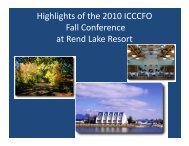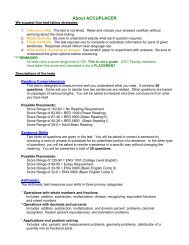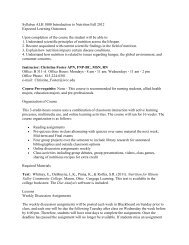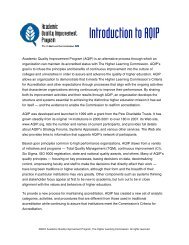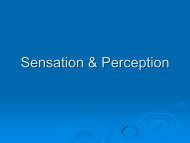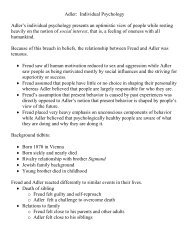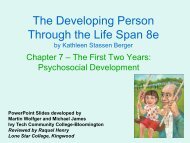Final Project Grading Rubric - IVCC
Final Project Grading Rubric - IVCC
Final Project Grading Rubric - IVCC
Create successful ePaper yourself
Turn your PDF publications into a flip-book with our unique Google optimized e-Paper software.
CAD 1205<br />
Animation <strong>Final</strong> <strong>Project</strong><br />
At completion of the semester in lieu of a final exam students submit an animation project that they<br />
create themselves by applying the techniques and tools they mastered over the course of the semester.<br />
This project is worth a maximum of 102 points, or 25% of the final grade for the semester.<br />
The project must include the following components:<br />
Be at least 300 frames<br />
Contain at least three distinctly different complex objects<br />
Utilize at least three different forms of animation<br />
Utilize a diverse pallet of materials, (preferably created by the student).<br />
Use at least one realistic lighting object, preferably utilizing advanced settings.<br />
Effectively use cameras, created by the student to focus the viewers attention and create an<br />
appropriate atmosphere<br />
Describe the process by which all components of the project were created.<br />
Students may pick their choice of subject matter and scenes, but must keep in mind that this<br />
project will be viewed by their all of their classmates.
Students must be respectful to all members of the class and the classroom environment, (<strong>Project</strong>s<br />
that contain profanity and inappropriate subject matter will be assigned a 0).<br />
Rationale for the Assignment:<br />
This assignment requires the student to demonstrate competency with the tools available in 3 D Studio<br />
Max. Students must be able to demonstrate that they can apply the techniques we have discussed and<br />
used in our weekly lab activities. By allowing the student to pick their choice of a story, subjects, and<br />
themes, I have found that they enjoy their work, and work more diligently on this activity then any of the<br />
other assignments.
Assessment <strong>Rubric</strong><br />
Category Excellent(20 Points) Good ( 17 Points) Fair (15 Points) Poor (12 Points)<br />
Original<br />
Objects<br />
Advanced Lofting<br />
and/ or<br />
Editable Polys that<br />
utilize at least three<br />
advanced editable<br />
poly functions, such<br />
as slice, connect,<br />
bevel, extrude,<br />
connect, paint<br />
deformation, and<br />
HSDS modifiers<br />
A diverse collection<br />
of original materials<br />
were created with<br />
procedural maps,<br />
composite maps and<br />
advanced shading<br />
functions.<br />
Modified<br />
primitive shapes,<br />
Boolean<br />
operations may<br />
be utilized, some<br />
modifiers have<br />
been applied.<br />
Shapes may be<br />
linked to each<br />
other.<br />
A minimal<br />
amount of work<br />
went into<br />
creating the<br />
objects. At least<br />
one modifier has<br />
been applied to<br />
each object<br />
Primitive<br />
unmodified,<br />
unlinked objects<br />
or unoriginal<br />
object<br />
Use of<br />
Materials<br />
One or two<br />
original material<br />
were used. The<br />
advanced<br />
material shading<br />
an tiling<br />
functions were<br />
used.<br />
Three types of<br />
animation were<br />
used, but not<br />
necessarily<br />
different types.<br />
No original<br />
materials were<br />
used. Some<br />
shading<br />
parameters were<br />
adjusted<br />
Little or no<br />
variety in<br />
materials.<br />
Shading<br />
parameters were<br />
not adjusted.<br />
Animation<br />
At least three<br />
different types of<br />
animation were used.<br />
(key frame, path<br />
constraints, particle<br />
systems, etc…)<br />
All animation<br />
revolves around<br />
the movement of<br />
one or two<br />
objects.<br />
Little or no<br />
movement in the<br />
project
Lighting<br />
Several types of<br />
lighting were applied.<br />
to effectively create a<br />
realistic scene.<br />
Shadow settings<br />
were optimized<br />
Excellent storyboard<br />
detailing all aspects<br />
of the story.<br />
Presenter can<br />
describe the methods<br />
by which all objects ,<br />
materials and the<br />
animation were<br />
created. Proper<br />
credit is given to the<br />
sources of unoriginal<br />
objects. Original files<br />
used to develop<br />
animation are<br />
submitted.<br />
Standard Lighting<br />
was used to<br />
create a realistic<br />
scene<br />
Some lighting<br />
was applied, but<br />
not effectively<br />
No lighting other<br />
then the default<br />
3d s max lighting<br />
was applied<br />
Presentation<br />
Good storyboard<br />
detailing overall<br />
story. Presenter<br />
can describe the<br />
basics of the<br />
methods used to<br />
create objects,<br />
materials and<br />
animation. All of<br />
the 3ds max files<br />
used to create<br />
project are<br />
submitted.<br />
Storyboard is<br />
submitted and an<br />
overview of the<br />
creation process<br />
is described.<br />
Most of the files<br />
used to create<br />
the animation are<br />
submitted.<br />
Storyboard is<br />
incomplete or of<br />
poor quality.<br />
Presenter does<br />
not describe<br />
creation process<br />
and fails to<br />
submit the<br />
majority of the<br />
3ds max files<br />
used to create<br />
the project.



